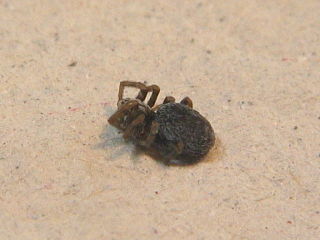
Scorpions are predatory arachnids of the order Scorpiones. They have eight legs, and are easily recognized by a pair of grasping pincers and a narrow, segmented tail, often carried in a characteristic forward curve over the back and always ending with a stinger. The evolutionary history of scorpions goes back 435 million years. They mainly live in deserts but have adapted to a wide range of environmental conditions, and can be found on all continents except Antarctica. There are over 2,500 described species, with 22 extant (living) families recognized to date. Their taxonomy is being revised to account for 21st-century genomic studies.

Mount Nebo is the southernmost and highest mountain in the Wasatch Range of Utah, in the United States. Named after the biblical Mount Nebo overlooking Israel, which is said to be the place of Moses' death, it is the centerpiece of the Mount Nebo Wilderness, inside the Uinta National Forest.

Marquis Giacomo Doria was an Italian naturalist, botanist, herpetologist, and politician.

Heliophanus is a genus of the spider family Salticidae. Most of the almost 170 described species occur in Africa, with many others found in the Palearctic region from Europe to Japan.

Phlegra is a genus of jumping spiders that was first described by Eugène Louis Simon in 1876. The name is a reference to a mythical location in both Greek and Roman mythology.

Pseudicius is a genus of the jumping spiders first described by Eugène Simon in 1885. The name is combined of Greek pseudo "false" and the salticid genus name Icius. The small genus Wesolowskana should possibly be included in this genus. There is some dispute whether Afraflacilla is a distinct genus or should be included in Pseudicius. Festucula and Marchena are other close relatives, these genera form a monophyletic group.

The Scorpionidae make up the superfamily Scorpionoidea. The family was established by Pierre André Latreille, 1802.

Nebo hierichonticus, the common black scorpion, is a species of scorpion in the family Diplocentridae.

Nebo is a genus of scorpions in the family Diplocentridae.

Diplocentridae is a family of scorpions. The roughly 120 species are mostly native to the New World, except for genus Nebo, which is distributed in the Middle East.

Archaeodictyna is a genus of cribellate araneomorph spiders in the family Dictynidae, and was first described by Lodovico di Caporiacco in 1928.

Scorpiops atomatus is a species of scorpion in the Euscorpiidae family, first found in Tibet and Yunnan, China.

Scorpiops langxian is a species of scorpion in the family Euscorpiidae, first found in Tibet, China.
Chaerilus tessellatus is a species of scorpion in the Chaerilidae family, first found in Tibet and Yunnan, China.

Cambalida is a genus of corinnid sac spiders first described by Eugène Simon in 1910.
Prodidomus is a genus of ground spiders that was first described by Nicholas Marcellus Hentz in 1847.
Kolotl is a genus of scorpions in the family Diplocentridae, native to Mexico. Named for the Nahuatl word for scorpion, they can be almost 10 cm long.

Diplocentrus is a genus of toothed scorpions in the family Diplocentridae. There are more than 60 described species in Diplocentrus, found mainly in Central American, Mexico, and the southwest United States.













